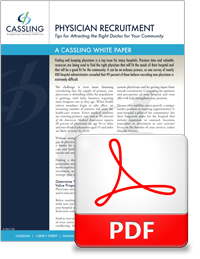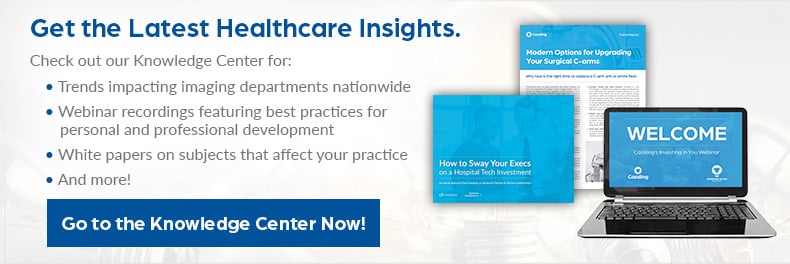Physician Recruitment – Tips for Attracting the Right Doctor for Your Community
by Cassling on Aug 7, 2014
 Finding and keeping physicians is a top issue for many hospitals. Precious time and valuable resources are being used to find the right physician that will fit the needs of their hospital and that will be a good fit for the community. It can be an arduous process, as one survey of nearly 400 hospital administrators revealed that 49 percent of them believe recruiting new physicians is extremely difficult.
Finding and keeping physicians is a top issue for many hospitals. Precious time and valuable resources are being used to find the right physician that will fit the needs of their hospital and that will be a good fit for the community. It can be an arduous process, as one survey of nearly 400 hospital administrators revealed that 49 percent of them believe recruiting new physicians is extremely difficult.
The challenge is even more daunting considering that the supply of primary care physicians is dwindling while the population is growing, with baby boomers requiring more frequent care as they age. When health reform mandates begin to take effect, an increasing number of patients will enter the healthcare system. Fewer medical students are choosing primary care, and as The Journal of the American Medical Association reports, 38 percent of physicians are age 50 or older and one-third of physicians aged 55 and older are likely to retire by 2020.
Without enough physicians there will be a gap in physician supply vs. demand, making it harder for patients to receive immediate care and further increasing the pressure to recruit and retain an adequate medical staff.
Finding a doctor with the skill set and personality attributes that match a hospital’s needs requires a substantial time and financial investment, so it’s important to begin with a strategic plan and a carefully crafted message.
Determine Your Differentiators and Value Proposition
Physicians need a good reason to choose you and to relocate their family to your community.
Before reaching out to potential candidates, make sure you’re clear on exactly what makes your hospital unique and what sets you apart from your competitors.
Analyze your market position and the strength of what you’re able to offer to candidates by conducting focus group discussions with current physicians and by getting input from outside constituents. Comparing the opinions and perceptions of your hospital and your offer will help strengthen your position.
Need help reaching the right physicians? We can help.
Do you offer stability, career growth, a unique market position or teaching opportunities? Is your hospital a pillar of the community? Are there long-term plans for the hospital that include expansion to outreach locations, renovation or investment in new systems? Focus on the benefits of your services, rather than the features.
Additionally, be aware of different generational work ethics and how your hospital and community can provide benefits that are important to physicians of all ages. While older physicians may prioritize work above other interests, younger physicians often value a work-life balance.
Finding the Ideal Candidate
Potential candidates can be found through a variety of methods, such as advertising with online job sites and with medical journals and association publications; sourcing state physician recruitment databases; direct mail and e-mail campaigns; targeted phone calls; on-site recruiting at conferences; hiring recruiting agencies and networking with healthcare executives and doctors from outside the hospital’s service area.
Established and new physicians receive an increasing number of offers; it is reported that residents can receive 50 or more solicitations across their training period. Therefore, it is important to make your opportunity stand out by avoiding fluff and keeping it as brief as possible. Put yourself in the physician’s shoes and craft your messages accordingly.
Retention begins during the first conversation or contact with the physician. When publicizing your opportunity or contacting a potential candidate, cut through the clutter and get to the point quickly with a clear headline or subject line that makes a clear but positive first impression.
Allison McCarthy of Barlow/McCarthy, a hospital-physician solutions firm, advises to avoid using terms that are generic (high-quality care) or cliché (wonderful place to work). To give your offer more impact, don’t attempt to be everything to all physicians and don’t use the same general terms that your competitors would use.
The Advisory Board recommends that hospitals spend disproportionate time finding and wooing high-quality candidates they have a reasonable chance of attracting and retaining. Studies show that for residents, geographic location is the most important factor in choosing a position. And for practicing physicians ages 41 and older, the top factor is compensation. Ultimately, candidate decisions are based on personal impressions of the hospital, medical staff and community value propositions.
Web Presence
Your website can be an easy way to showcase your organization and your community to prospective physicians, especially those that might not be able to visit the hospital in person. Hospitals with best practice recruitment pages on their website make them easily accessible from the home page and feature a variety of resources:
- Community links: New physicians almost always search online for community information before researching local hospitals. Include links to community websites and use a rural setting as selling point, emphasizing the small, family-friendly setting to those with young children.
- Input from physician families: Spouses often play a big part in making relocation decisions. Add video from physician’s families sharing what they like about the community.
- Testimonials from doctors: Consider adding video from staff physicians sharing what they like about practicing there (modern technology in a rural setting, physician/patient relationship, ability to provide quality, personalized care, specialist access, etc.).
- Online tour: Include highlights of the practice environment (technology, leadership, training, call schedule, etc.) and offer a virtual tour of hospital areas.
Academic Programs
Typically, residents start searching and deciding on an opportunity in their next-to-last year.
Some hospitals are cultivating relationships even earlier with local students that plan on attending medical school in hopes that they will want to return home to practice medicine. Medical schools are targeting students from underserved areas that would like to return home by speaking to classes and inviting them to recruitment luncheons at the hospital. Others have successfully recruited students through scholarship and loan repayment offers.
Rural Recruitment Hurdles
Rural areas already have a shortage of physicians because most young doctors prefer to practice in urban areas. Doctors that practice in rural areas often are overworked, with long hours and a patient base consisting of many elderly, uninsured and Medicare patients. About 20 percent of the U.S. population (more than 50 million people) live in rural areas, but only 9 percent of the nation’s physicians practice in rural communities, according to the
Health Resources and Services Administration.
Physicians trained in osteopathic medicine are 2.3 times more likely than other physician groups to practice rural primary care, reports the Journal of the American Osteopathic Association. To promote the benefits of practicing in a rural community, hospitals should promote strengths such as cooperative physicians and administrators, call arrangements or covered emergency room on weekends, specialists that rotate into the hospital or that are available for consultations, a stable economy and good schools.
Organizations experiencing recruitment challenges have joined regional collaborative initiatives such as the Missouri, Iowa, Nebraska and Kansas (MINK) Physician Recruitment and Retention Network (www.mink-midwest.org). In addition to a website offering regional opportunities and resources to physicians, MINK offers joint marketing and advertising opportunities to help increase hospital visibility.
The Advisory Board also recommends approaching local tertiary hospitals or state academic medical centers to see if they would co-sponsor recruitment of a physician, which would give physicians the benefit of AMC activities while allowing them to practice at rural hospital.
Hosting a Successful Site Visit
Before investing in a site visit, the Society of Healthcare Market Strategy and Development advises pre-screening a candidate through a phone interview and conducting a background check through the National Practitioner Data Bank (www.npdb-hipdb.com).
Make sure a draft contract is prepared before the site visit; if the candidate is a good fit and if key constituents agree, an offer can be given at the end of the visit.
The site visit should demonstrate everything that was promised in your value proposition and should “sell” the candidate (and their spouse) on the position and the community. A typical site visit includes greeting at airport by the recruiter or hospital leadership, a hospital tour, meeting with key decision makers (CEO, CMO, CNO, practice partners, etc.), a tour of the community with a realtor, dinner with current physicians and hospital leadership, and other social opportunities.
Most candidates will make a decision within a week. Call the physician and their spouse two days after the visit to follow-up and to convey your excitement. Organize an internal debrief as well to gather feedback on the visit’s successes and challenges in order to improve the next site visit.
Keeping New Recruits On Board
Scrambling to hire a physician just to “fill a spot” can potentially double the cost to fill the position again if the recruit doesn’t stay on board. Cejka Search reports that the average hospital experiences extremely high turnover, with half of its new recruits leaving within five years.
Be proactive by providing support and constant communication. The three most critical phases are signing to start date, start date to 90 days and from 90 days onward. Consider meeting with new physicians and spouses on monthly basis during the first year to make sure they are adjusting to the community and to address concerns. Other hospitals encourage new doctors to network with more established physicians.
If your hospital offers quality patient care, an excellent support staff, technology, open and innovative leadership and a culture that supports physician involvement in decision making, your chances of retaining your valuable recruit are high. Communicate, communicate, communicate, and use feedback from your new doctor during the recruitment process for your next new physician.
Meet the Author
Cassling strengthens community healthcare through customer-centric imaging and therapeutic technology, services and solutions. From critical access hospitals and diagnostic imaging centers to large health systems and IDNs, Cassling is committed to helping healthcare organizations improve access and outcomes, create efficiencies and lower costs.





Comments